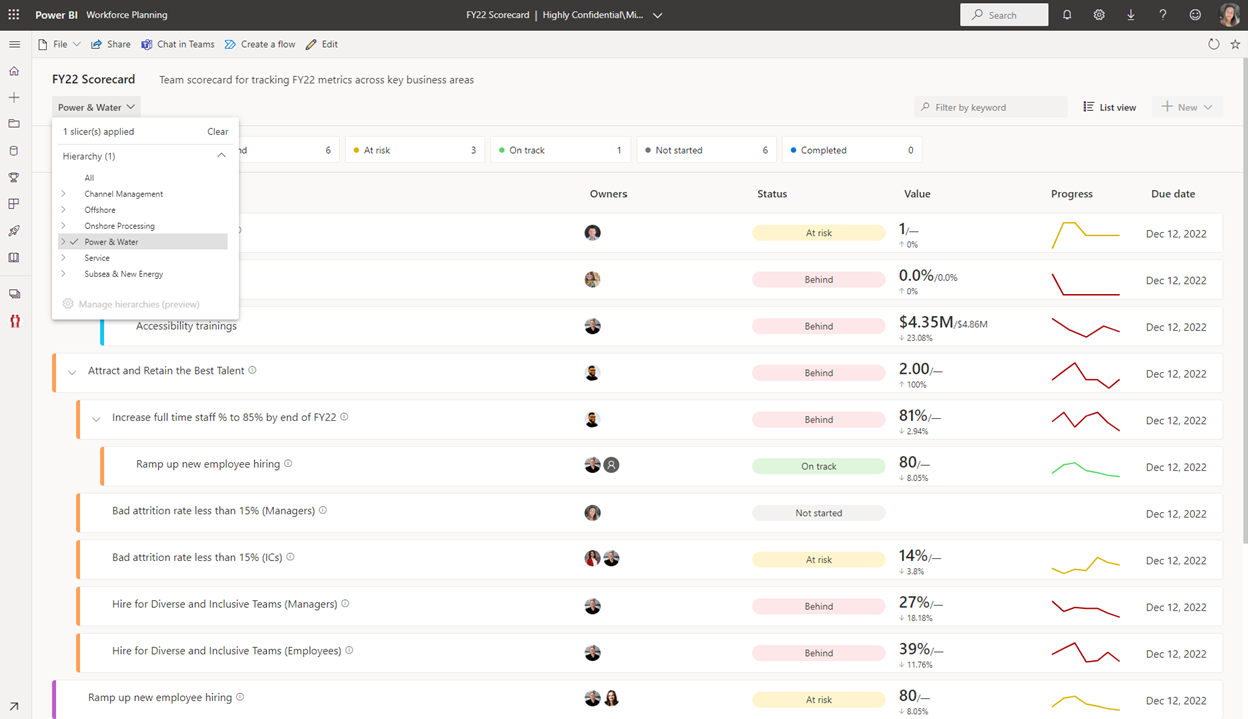Commencez avec les hiérarchies dans les tableaux de bord Power BI
S’APPLIQUE À :️ Power BI Desktop
Service Power BI
Les métriques prennent en charge les tableaux de bord en cascade qui se regroupent selon les hiérarchies que vous avez configurées dans votre tableau de bord. Vous pouvez configurer une hiérarchie pour une carte de performance et mapper les modèles sémantiques Power BI référencés par vos objectifs aux niveaux de hiérarchie et aux champs propriétaires, créant automatiquement une nouvelle vue de carte de performance pour chaque tranche de vos données.
Conditions préalables à la création de hiérarchies
Voici les conditions requises pour configurer une carte de performance hiérarchique :
- Les hiérarchies nécessitent un espace de travail Premium ou Premium par utilisateur.
- Vous avez besoin d’autorisations pour Modifier le tableau de bord.
- Votre tableau de bord doit comporter au moins un objectif connexe.
- Vous avez besoin d’un accès Build aux modèles sémantiques connectés dans votre tableau de bord.
Apparence des hiérarchies dans les cartes de performance
Power BI va propager les objectifs liés à tous les niveaux de la hiérarchie. Les utilisateurs peuvent facilement explorer la hiérarchie pour voir la progression, les statuts et effectuer des points de suivi à différents niveaux. Dans les images suivantes, vous voyez les différents niveaux d’une hiérarchie de projet dans le segment. Lorsque vous accédez à chaque objectif ou sous-niveau de la hiérarchie, vos valeurs des indicateurs, vos statuts, vos responsables et votre progression changeront en conséquence.
Ce tableau de bord est configuré avec une hiérarchie, et le filtre est ouvert pour exposer le segment de hiérarchie :
Dans cette image, le filtre est ouvert en exposant le segment de hiérarchie et les filtres appliqués sur le tableau de bord :
Paramétrez votre hiérarchie (aperçu)
Dans le mode Édition du tableau de bord, sélectionnez Configurer une hiérarchie dans le menu Nouveau.
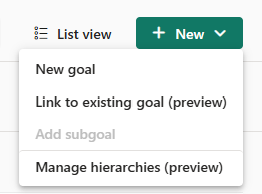
Vous pouvez également sélectionner Gérer les hiérarchies dans le segment Tout.
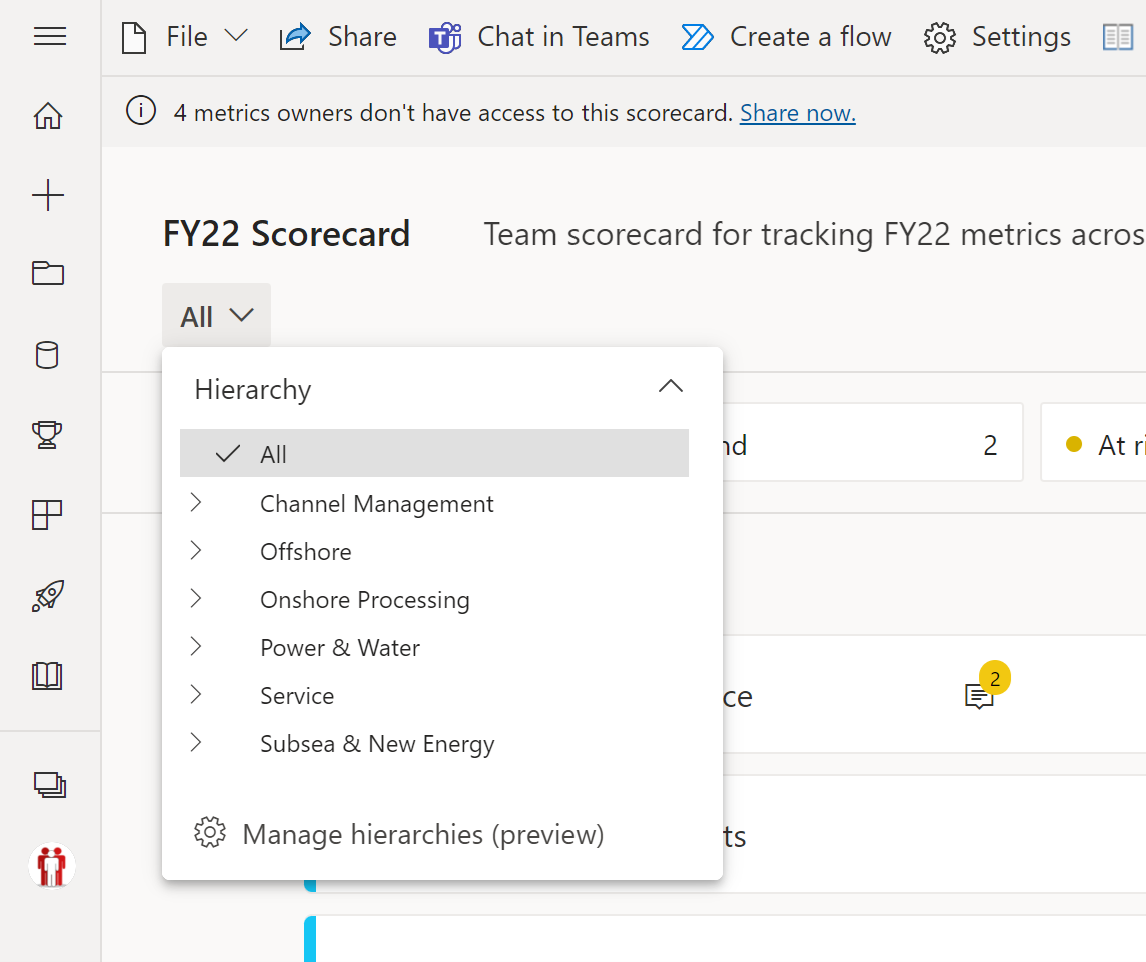
Mapper les niveaux de hiérarchie aux données
Commencez à configurer votre hiérarchie en lui donnant un nom, en créant les niveaux et en les mappant aux modèles sémantiques connectés dans votre carte de performance. Vous pouvez créer plusieurs hiérarchies pour croiser les données, par exemple s'il existe une hiérarchie géographique et une hiérarchie produit, vous pouvez utiliser les filtres pour afficher un tableau de bord montrant vos métriques par « ordinateurs portables en Allemagne » ou « appareils intelligents à Seattle, Washington ».
Dans l’expérience d’installation, vous voyez tous les modèles sémantiques connectés aux métriques dans la carte de performance.
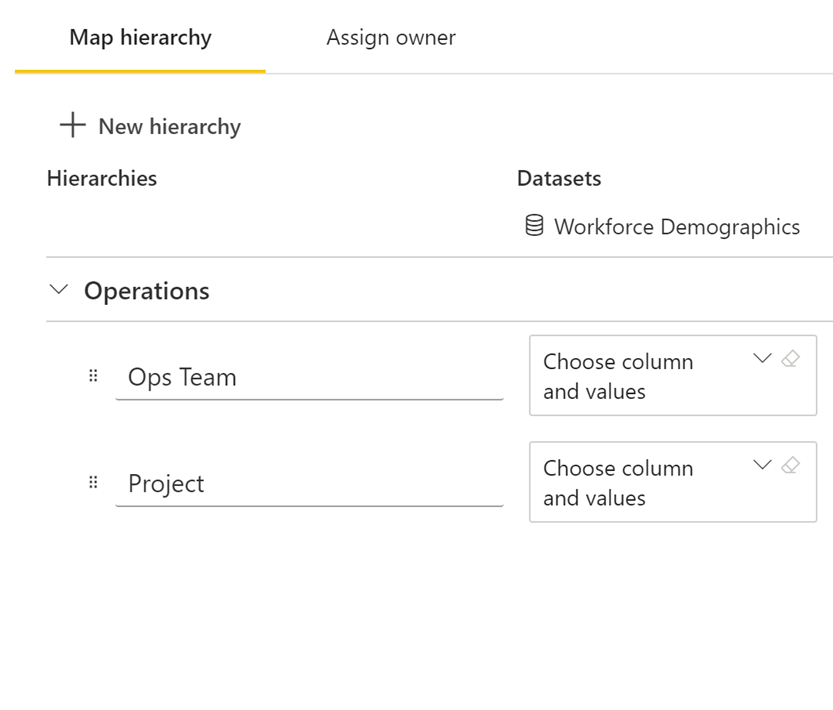
Mappez les données de vos modèles sémantiques sous-jacents à vos niveaux hiérarchiques. S’il existe des champs que vous ne souhaitez pas intégrer dans le mappage, vous pouvez les désélectionner à l’aide des cases à cocher dans la liste des champs.
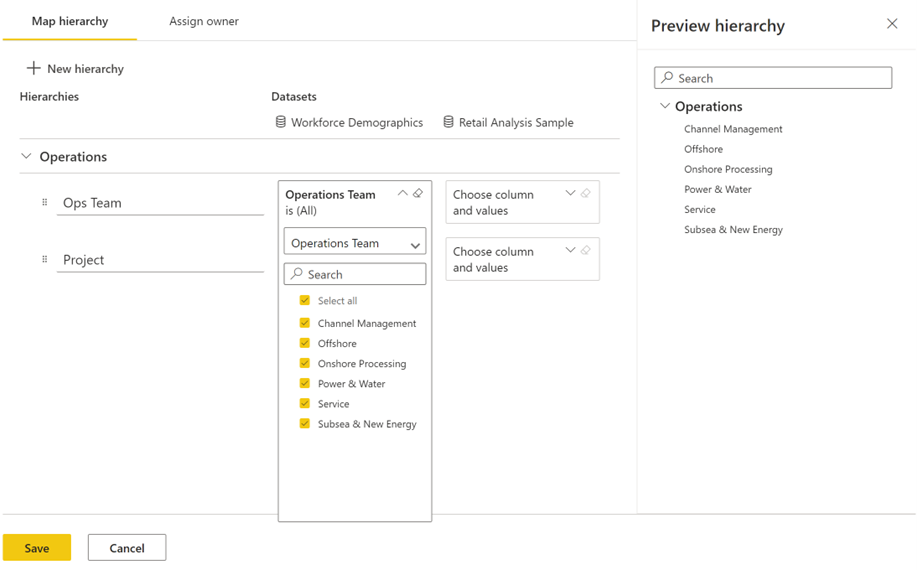
Lorsque vous mappez vos modèles sémantiques aux données correspondantes dans chaque niveau de hiérarchie, vous voyez un aperçu dans le volet de droite pour vérifier que vous êtes sur la bonne voie.
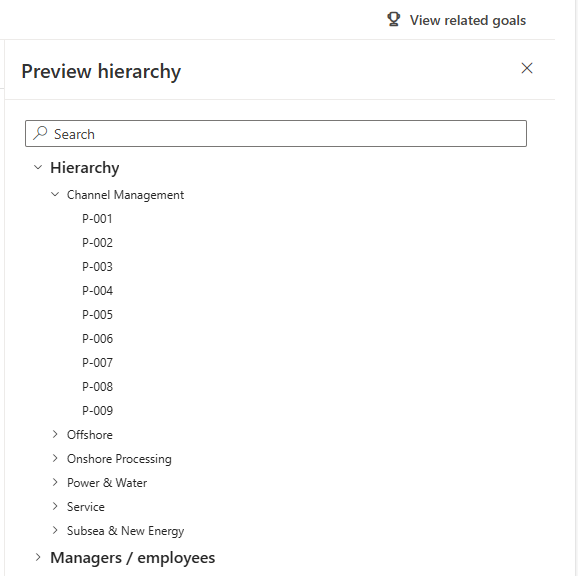
Il existe également une option en haut à droite pour afficher les métriques associées, montrant une vue d’ensemble des métriques sur votre carte de performance, quelles valeurs sont connectées aux données et quel modèle sémantique ils proviennent.
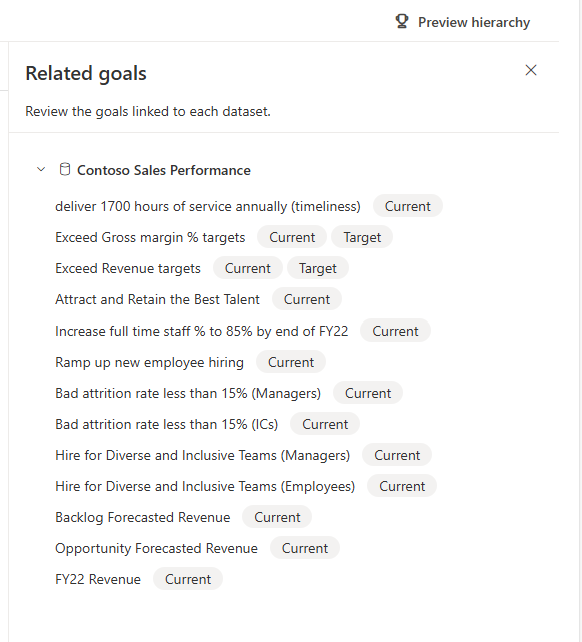
Mapper les propriétaires
Vous pouvez mapper les propriétaires dans la section attribuer des propriétaires afin que la colonne propriétaire change dynamiquement avec chaque tranche des données. Les propriétaires sont mappés par hiérarchie. Par conséquent, pour qu’un mappage de propriétaire fonctionne correctement, il doit y avoir une relation entre le champ propriétaire et les données de hiérarchie dans les modèles sémantiques sous-jacents. Les mappages de propriétaire s’appliquent par niveau de hiérarchie, et non par métrique.
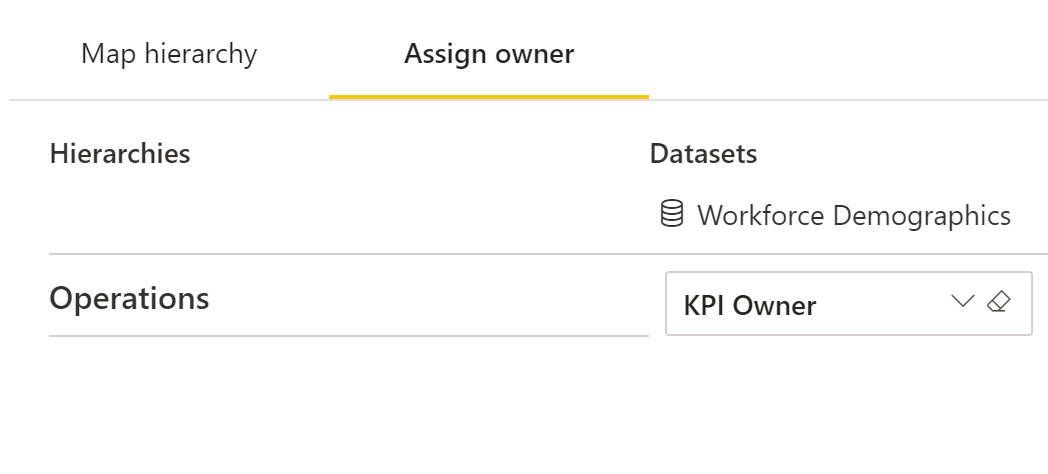
Enregistrez votre hiérarchie et observez que toutes les valeurs connectées et les propriétaires changent dynamiquement. Les hiérarchies prennent également en charge les objectifs manuels (objectifs non connectés aux données) : les objectifs manuels s’affichent sur les cartes de performance enfants, mais affichent les valeurs manuelles comme vides. Ces objectifs peuvent être enregistrés et mis à jour dans les vues du tableau de bord enfant.
Autres données de métrique héritées de la carte de performance d’origine :
- Métadonnées de métrique : nom, propriétaires, états et dates de début et d’échéance
- Connexions de données
- Règles de statut
- Paramètres de suivi
Données métriques qui peuvent être modifiées sur des cartes de performance des enfants :
- Données d’archivage : notes, états (le cas échéant) et valeurs (le cas échéant).
Considérations et limitations
Il existe des limites de données sur les hiérarchies :
- Jusqu’à 10 000 éléments par hiérarchie (sur tous les modèles sémantiques)
- Jusqu’à cinq hiérarchies
- Jusqu’à cinq niveaux par hiérarchie
La sécurité dynamique et statique au niveau des lignes (RLS) est prise en charge, mais elle est cependant routée via le créateur de hiérarchie. Tous les utilisateurs du tableau de bord imitent l’accès du créateur de la hiérarchie.
Les autres utilisateurs disposant d’un accès de modification au tableau de bord peuvent modifier la hiérarchie, mais leurs modifications prennent en charge les connexions de la hiérarchie lors de l’enregistrement, ainsi que toutes les données. Les connexions sont routées via leur ID d’utilisateur, ce qui peut entraîner des valeurs de données différentes ou des métriques rompues.
La réutilisation des hiérarchies Power BI n’est pas encore prise en charge. Vous devez créer des hiérarchies dans chaque tableau de bord.
Pour que les hiérarchies reflètent les modifications appropriées, vous devez avoir établi des relations entre les champs de hiérarchie dans les données sous-jacentes. C’est vrai aussi pour les propriétaires.
Les hiérarchies ne sont pas incluses dans le modèle sémantique de carte de performance.
Les propriétaires mappés dans la hiérarchie ne reçoivent pas automatiquement des autorisations sur le tableau de bord.
Les responsables sont assignés par niveau hiérarchique, pas par métrique.
Les cumuls ne sont pas encore pris en charge sur les tableaux de bord enfant.

